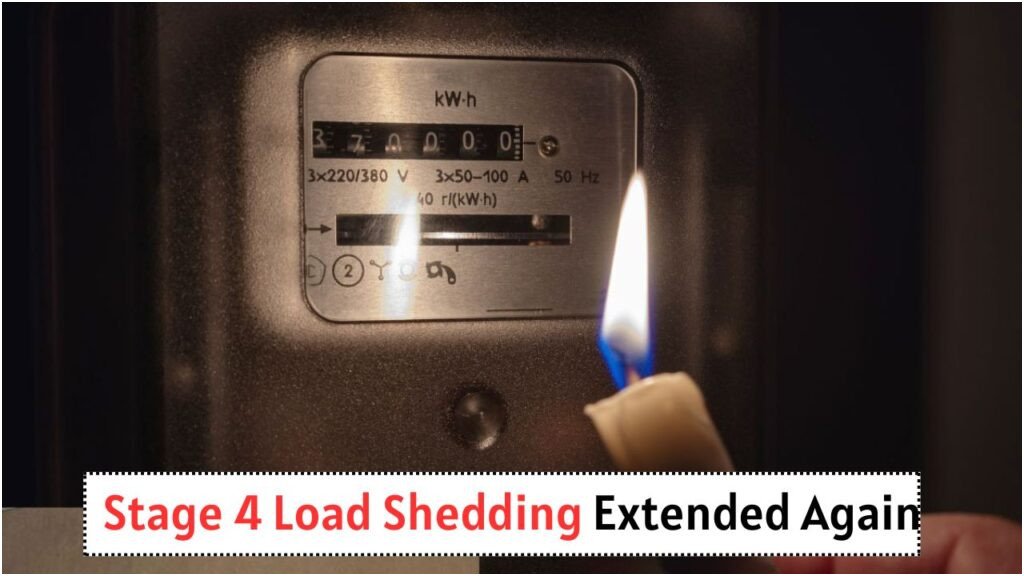Stage 4 Load Shedding Persists: South Africa continues to grapple with ongoing power challenges as Stage 4 load shedding remains in effect until August 9. This persistent power interruption impacts various regions across the nation, requiring citizens to stay informed and prepared. As Eskom, the national power utility, works tirelessly to manage the electricity grid, it is crucial for residents to know which areas are affected and how to mitigate the impact on their daily lives. Understanding the intricacies of load shedding schedules can help minimize disruptions and ensure that South Africans can plan effectively to navigate this challenging period.
Understanding the Impact of Stage 4 Load Shedding in South Africa
Stage 4 load shedding is a critical measure implemented when the national grid is under significant pressure, often due to insufficient generation capacity or technical failures. During this stage, approximately 4,000 MW needs to be shed, leading to more frequent and longer power outages in various areas. The impact is felt across households, businesses, and essential services, causing disruptions in daily routines and economic activities. In South Africa, this level of load shedding can occur several times a day, with outages lasting for up to four hours per session. This necessitates strategic planning and adaptation for both individuals and businesses to manage their activities efficiently.
- Reduced productivity in businesses due to power outages.
- Increased reliance on alternative energy sources like generators or solar power.
- Challenges in maintaining food safety due to refrigeration issues.
- Interrupted access to digital services and communication networks.
- Potential safety concerns during extended periods of darkness.
Regions Most Affected by Load Shedding Until August 9
As Stage 4 load shedding persists, it is essential to identify which areas in South Africa are most impacted. This helps residents plan their activities around scheduled outages, reducing the inconvenience caused by sudden power cuts. Typically, large metropolitan areas like Johannesburg, Cape Town, and Durban experience significant disruptions due to their high energy demands. However, rural regions are not exempt and often face unique challenges due to their limited access to alternative power solutions. The following table outlines some of the key areas currently affected, allowing residents to stay informed and take necessary precautions.
| Region | City/Town | Expected Outages | Alternative Power Solutions | Community Support Initiatives | Impact on Local Economy |
|---|---|---|---|---|---|
| Gauteng | Johannesburg | 3-4 sessions daily | Solar panels, generators | Local business coalitions | High |
| Western Cape | Cape Town | 2-3 sessions daily | Wind energy, UPS systems | Community outreach programs | Moderate |
| KZN | Durban | 3 sessions daily | Battery storage solutions | Municipal support services | Moderate |
| Eastern Cape | Port Elizabeth | 2 sessions daily | Hybrid systems | Local NGO initiatives | Low |
| Limpopo | Polokwane | 1-2 sessions daily | Diesel generators | Community forums | Low |
| Mpumalanga | Nelspruit | 2-3 sessions daily | Solar and wind combinations | Regional workshops | Moderate |
How to Cope with Load Shedding in South Africa
Adapting to Stage 4 load shedding requires proactive measures to minimize disruptions and maintain a semblance of normality. For households, investing in alternative power solutions such as solar panels, battery backups, or generators can provide relief during outages. Businesses can benefit from energy-efficient practices and backup power systems to ensure continuity. Additionally, staying informed about load shedding schedules through reliable sources is crucial for effective planning. The following list provides practical tips for coping with load shedding:
 SASSA Child Grant: R560 Payments Set for August 22, 2025 – Ensure Your Bank Details Are Up-to-Date!
SASSA Child Grant: R560 Payments Set for August 22, 2025 – Ensure Your Bank Details Are Up-to-Date!
- Subscribe to Eskom’s notifications or local municipality alerts for schedules.
- Charge essential devices in advance to stay connected during outages.
- Use energy-efficient appliances to reduce overall consumption.
- Install surge protectors to safeguard electronics.
- Plan activities around load shedding times to maximize productivity.
Economic Implications of Load Shedding in South Africa
The economic ramifications of prolonged load shedding are profound, affecting both micro and macroeconomic levels. Businesses, especially small and medium enterprises, face increased operational costs due to the need for alternative power sources and reduced productivity during outages. This can lead to higher prices for goods and services, impacting consumers and the overall economy. Furthermore, frequent power cuts can deter foreign investment, as reliability is a key factor for investors. The following list highlights some of the economic implications:
- Increased operational costs for businesses.
- Potential job losses due to reduced business output.
- Negative impact on investor confidence.
- Higher inflation rates as production costs rise.
- Strain on government resources to manage energy infrastructure.
FAQ Section
| Question | Answer | Category |
|---|---|---|
| What is Stage 4 load shedding? | A level where 4,000 MW is shed, causing frequent outages. | Load Shedding |
| How long will Stage 4 load shedding last? | Currently expected until August 9, but subject to change. | Duration |
| How can I find out my area’s load shedding schedule? | Check Eskom’s website or local municipality alerts. | Information |
| What are some alternative power solutions? | Solar panels, generators, battery backups. | Solutions |
| What impact does load shedding have on the economy? | Increases costs, affects productivity, and deters investment. | Economy |
Community Initiatives to Support Affected Areas
In response to the ongoing Stage 4 load shedding, various community initiatives have emerged to support affected populations in South Africa. These initiatives aim to provide relief and assistance to those most impacted by power cuts, particularly in regions with limited access to alternative energy solutions. From local business coalitions offering shared generator resources to NGOs providing educational workshops on energy conservation, these efforts are crucial in helping communities adapt and thrive amidst challenging circumstances.
Government Efforts to Mitigate Load Shedding
The South African government, alongside Eskom, is actively working to address the underlying causes of load shedding and improve the country’s energy infrastructure. Recent efforts include investing in renewable energy projects, upgrading existing power plants, and promoting energy efficiency initiatives across industries. These measures are designed to enhance the stability of the national grid and reduce the frequency and severity of load shedding events. However, achieving long-term solutions requires continued collaboration between government entities, private sector partners, and the public.
- Investment in renewable energy sources.
- Infrastructure upgrades for aging power plants.
- Promotion of energy efficiency in industrial sectors.
Technological Innovations to Combat Load Shedding
Innovative technologies play a vital role in combating the effects of load shedding in South Africa. As the country seeks to transition towards a more sustainable energy model, advancements in solar technology, battery storage, and smart grid systems are gaining traction. These innovations not only offer immediate relief during power outages but also contribute to long-term energy resilience. By adopting these technologies, South Africa can reduce its reliance on traditional power sources and move towards a cleaner, more reliable energy future.
 NSFAS R5,200 Allowance Deposits Begin September 8, 2025 – Ensure Your Bank Details Are Correct
NSFAS R5,200 Allowance Deposits Begin September 8, 2025 – Ensure Your Bank Details Are Correct
- Solar technology advancements.
- Battery storage systems.
- Smart grid infrastructure.
Long-term Strategies for Energy Security in South Africa
To ensure long-term energy security, South Africa must implement comprehensive strategies that address both current challenges and future demands. This involves diversifying the energy mix to include a larger share of renewables, enhancing grid management capabilities, and fostering innovation in energy technologies. Additionally, policies that encourage private sector investment and community participation are essential in building a resilient energy system. By focusing on these strategies, South Africa can achieve a more sustainable and stable energy supply, reducing the impact of load shedding on its citizens and economy.
Frequently Asked Questions
| Question | Answer | Category |
|---|---|---|
| How does load shedding affect daily life? | Disrupts routines, affects businesses, and can compromise safety. | Daily Impact |
| Can renewable energy reduce load shedding? | Yes, it offers a sustainable alternative to traditional power sources. | Energy Solutions |
| What is the government’s role in addressing load shedding? | Investing in infrastructure, promoting energy efficiency, and policy-making. | Government Efforts |
Conclusion
In conclusion
load shedding remains a significant challenge
for South Africa, requiring ongoing efforts
from government, businesses, and communities
to find sustainable solutions and ensure energy security.




